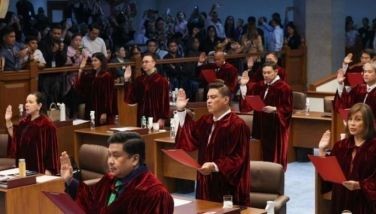Writing features painlessly

I am happy to be invited to the National Schools Press Conference in Koronadal, South Cotabato, on the third week of February.
I was first invited to a student press conference ages ago, where I was asked to write about feature writing. I said that writing features can be done painlessly, with tongue on cheek. Of course, there is no such thing. Any kind of writing – be it a poem, a story, a novel, a play or, yes, a feature article – involves some struggle. The poet T.S. Elliot called writing “this intolerable wrestling with words.”
The Random House Dictionary defines a feature as a “newspaper or magazine article or report of a person, event, an aspect of a major event, or the like, often having a personal slant and written in an individual style.”
When I was in college, Letty J. Magsanoc was fired from her post as the editor-in-chief of Philippine Panorama, the Sunday magazine of the Bulletin Today. Panorama was a wonder, like a buffet lunch every Sunday: Chelo Banal, Domini Torrevillas-Suarez and Lorna Kalaw-Tirol were there, all these brave women. One day, after Ferdinand Marcos had named himself both President and Prime Minister at the same time, Letty picked up pen and paper and wrote an article about the presidential speech at the Rizal Park.
She said it sounded like a high-school student’s speech, filled with rhetoric and nothing else. The sipsips (toadies) of Mr. Marcos brought him copies of Panorama, the late Brig. Gen. Hanz Menzi, the Bulletin publisher, was summoned to Malacañang and given a dressing down. Soon, Mr. Menzi – the former personal pilot of Mr. Marcos – asked Letty to resign. She did.
I compiled her articles, traced the events leading to her resignation, and then wrote about it. The Guidon published it and Letty thanked me through her daughter, Kara, who was also studying at Ateneo.
After college, I applied for a job at the Bureau of National and Foreign Information, which wanted to revive Archipelago, an art and culture magazine. They asked me to interview the now-departed historian, Professor Teodoro Agoncillo. His wife, Anacleta, said I could do so, but only for an hour, since the professor was busy writing his next book. I read everything I could find about him – his previous interviews, his CV, two of his books – before I went to his house.
Professor Agoncillo was wearing a white T-shirt and knee-length puruntong shorts. He was in his element, slashing at his critics with his tongue as sharp as a scythe. But he said that most of his comments are “off the record,” so I just put down my pen and paper and sipped the coffee he had offered to me. But Professor Agoncillo was also a man of tenderness, especially when he spoke about his children, one of whom, he said, was sick. He just kept on talking for almost three hours. Of course I was glad: I had a lot of material for my article.
He even brought me to the second floor of his house, to his library full of books and magazines dating back to the 1920s. He also showed me the first drafts of his books, which he had bound, and the awards he had received. Only then did I discover that the historian, Professor Agoncillo, also wanted a place in history. Nothing wrong with that. We all write because we hope that our books would outlive us.
I guess one secret in interviewing for a feature is to do your homework. Have you read the author’s books? Do you have a copy of his CV? Who among his friends could throw in an anecdote, an episode, which could illumine your subject’s inner life?
All of us have inner lives that go on and on, sometimes in contrast to the mask we were in public. Good journalists should ask the tough questions, the right questions, probing but not prying. If you are sensitive enough, or lucky enough (because you need a lot of luck in this business), the subject will say or do something that will open a door to that inner life.
Other subjects for my interview weren’t as serious as Professor Agoncillo. When I was working as a reporter for a newspaper in 1986, so-called penetration movies began, well, entering the silver screen. During a meeting, Yen Makabenta, my editor-in-chief, said that we should write about them. “Somebody should watch these ‘pene’ movies and interview one director,” Yen said, rolling his rrrs.His sharp eyes scanned the faces of the staff. The staff looked as dead as PhDs. Finally, Yen looked at me and assigned the job to the youngest person in the totem pole.
I borrowed two or three “pene” tapes from our friendly neighborhood video store and watched them with my brother and sisters, who promptly fell asleep. The tapes were dubbed in garbled English (they were being exported to Hong Kong and the US West Coast). The sex acts began to look like acrobatic exercises. After watching the tapes, I set an appointment with one of the directors, who wanted to be interviewed in a smoky beerhouse he owned. I said my lungs were bad and could I just talk to him at home? He said “No” so I asked a fellow staff writer if he knew another bold-movie director.
Thus I was able to talk to Mr. Ruben Abalos, who had directed such masterpieces in Saging ni Pacing (Pacing’s Banana) and Dingding Lang ang Pagitan (Only a Wall Between Us). He said he had just been appointed as OIC Vice-Mayor of a town in Pangasinan, so I asked him, what he would do for the town? “Show my movies in the theaters, what else,” he said, “to educate the young people!” It was already 2 a.m., two hours past my bed time. I looked outside, in the snoring darkness, and thought: Lord, could you give me another job?
But I will never leave journalism, even if some wags call it “literature in a hurry.” If done well, it’s still literature. The glory of the byline whether in print or on screen or on the air is one of the few real pleasures in life. As the Random House definition states, you can put your own indelible stamp onto your feature; you can impress your thumb mark on it. That’s why good journalists should be alert, their noses always sniffing for news.
How to do all these? Use the tools of fiction in your features: crisp dialogue, the telling detail, description with the clarity of water. Read Truman Capote’s Music for Chameleons, and learn the art of New Journalism (not really new, but still helpful). Observe people with the sharpness of a spy, with the delight of a lover. Open the pores of your skin. Listen to gossip, but don’t believe them. Believe the essayist Michel de Montaigne when he said, “Nothing human is alien to me.” Write with daring and with dash.
Live.
Comments can be sent to danton.lodestar@gmail.com
- Latest
- Trending






























